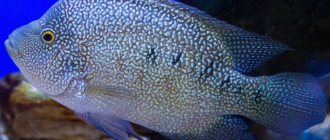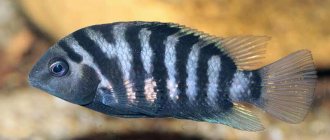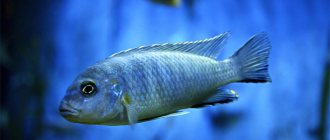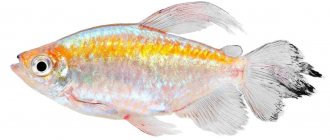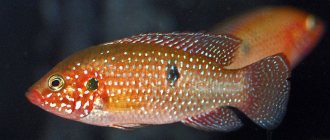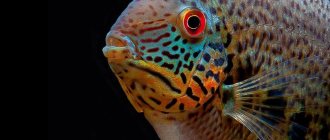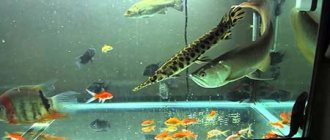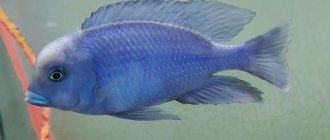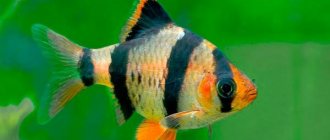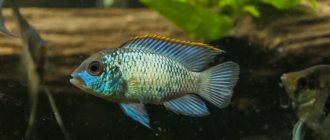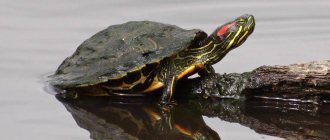Amatitlania nigrofasciata
The genus Cichlasoma has approximately 100 species, but the systematization and classification of this genus is constantly varying and changing. By the way, officially, the genus “Cichlazoma” essentially does not exist at all. They were all distributed into different clans. For example, with the black-striped cichlasoma - generally a guard! She is now Cryptocheros, and even sometimes Archocentrus and Amatitlania. And the diamond cichlasoma (formerly Cichlasoma cyanoguttatum) is now in general, most often Herichthis carpintis. These are the pies, friends!
Black-striped cichlasoma is one of the most popular fish of the cichlasoma family. These are relatively small, unpretentious fish, with a beautiful, sophisticated body color and, importantly, unlike many cichlids, they have a calmer character.
Some might say that the peak of their popularity has passed, that now there are many other more colorful forms of cichlids and cichlases in particular. However, the statistics don’t lie! Today, the black-striped cichlasoma, the most popular of all cichlasomas in the Yandex search. Every month more than 2200 users of this search engine apply for this request.
Black-striped cichlasoma
Well, let's look at this representative of the aquarium world in more detail.
Latin name: Cichlasoma nigrofasciatum - old, new - Amatitlania nigrofasciata. From the Latin words “nigro” - black and “fascia” - ribbon, belt, stripe.
Russian synonyms: Black-striped cichlazoma, black-striped cichlamosis, black-striped cichlamosis.
Foreign names: Zebra Cichlid, Zebra chanchito, Convict Cichlid, Zebrabuntbarsch Grunflossenbuntbarsch, Blaukehlchen.
Order, suborder, family: Perciformes, Perciformes, Cichlidae.
Comfortable water temperature: 20-28 C.
"Acidity" Ph: 6.8-8.0.
Hardness dH: 8-30.
Behavior: 30% are relatively non-aggressive, they show aggression during the period of spawning and caring for offspring.
Content difficulty: easy.
In nature, these cichlazomas live in lakes and streams of Guatemala, Panama, Honduras, Nicaragua and Costa Rica.
Black-striped cichlazoma photo
Description: the body of cichlazoma is tall, slightly elongated in length and compressed on the sides. The head is large, the eyes are large, the lips are thick. The body and fins of cichlazoma are colored grayish-blue, gray. 8-9 black stripes run along the body. The size of the fish in the aquarium reaches a maximum of 10cm. The male is larger and brighter than the female.
History: First described in 1867, first brought to Europe by Johann Paul Arnold in 1934.
Compatibility The black-striped cichlasoma is a surprisingly easy-going fish. And this despite the fact that she is a prominent representative of the aggressive family - cichlids. He has a calm disposition and is friendly even to small neighbors. You can conduct “experiments” with this fish and add relatively compatible fish to it; this issue is described in more detail in this article Compatibility of aquarium fish . As recommendations, it is advisable to keep the black-striped cichlid with other medium and small cichlids: parrot, diamond cichlid. Barbs, gouramis, swordtails and thorns can also get along with them. Black-striped cichlazoma calmly reacts to labeos, bots, thoracatums, and corydoras. However, you need to be careful when it comes to the compatibility of this fish with catfish. After all, the black-striped cichlid spawns at the bottom of the aquarium and the catfish will especially interfere with this process by swimming into the territory of the cichlids. As a result, there will be skirmishes and fights in the aquarium.
Black-striped cichlazoma photo
Incompatible: black-striped cichlasoma will not get along with large and aggressive fish: astronotus, acaras, piranhas. And on the contrary, fish that are too small and slow will not get along with it: small tetras, the family of goldfish, guppies, mollies, and other platies (with the exception of swordtails).
How long do they live: black-striped cichlasomas are a long-lived aquarium fish and can live more than 10-15 years. You can find out how long other fish live HERE!
Minimum aquarium volume: black-striped cichlids are not very large cichlids; an aquarium of 100 liters or more would be best for keeping them. for a couple. However, there have been cases of keeping black stripes in a 50 liter aquarium. In such an aquarium, the fish will be uncomfortable, they will not grow, and the breeding process will be in question. Find out how many other fish you can keep in X aquarium HERE (at the bottom of the article there are links to aquariums of all sizes).
Requirements for care and conditions of maintenance: black-striped cichlazoma is unpretentious in care. Ensuring optimal aquarium water parameters is the key to their successful maintenance and breeding. That is why many aquarists recommend that everyone who wants to start working with cichlids starts with these fish.
Black-striped cichlazoma photo
Perhaps, when keeping the black-striped cichlizoma, special attention should be paid to the bottom and soil of the aquarium, as well as proper zoning of the aquarium.
The fact is that these cichlids really like to “rummage in the soil”, turning it upside down at their discretion. Medium and fine-grained pebbles, gravel, and granite chips can be recommended as soil. Finer soil, for example sand, is not suitable for cichlases.
Zoning of the aquarium is carried out by such decorative elements as: grottoes, rocks, driftwood, caves, etc. Proper division of the aquarium into zones can also be done with the help of plants with a powerful root system, for example, Cryptocorynes or Echinodorus, as well as Vallisneria. At the same time, it is important to root the plants correctly - they are surrounded and pressed down with larger stones and other decor, so that the black-striped cichlids do not dig them up.
If you plan to breed these fish, then the aquarium bottom must also be equipped with a flat stone, a pot, or other similar decoration, which cichlids use as a substrate for spawning. In my opinion, even if you have no particular desire to breed your pets, such decor should be in a pond. After all, an aquarium is an imitation of the natural habitat conditions of fish, and the environment in the aquarium as close as possible to them will be comfortable for the fish.
Filtration, aeration and weekly changes of up to 1/3 of the water volume are also necessary. There are no special requirements for aquarium lighting.
The most important thing is that there are no excessive concentrations of nitrogen compounds and phosphates . This is the main problem for fish that beginners make. Ammonia, nitrite, nitrate, phosphates are the root cause of illness and death in pets. Every conscientious aquarist should always have a set of drop tests on hand, at least for nitrate and phosphate. Fortunately, they have now become inexpensive, there are no problems with their assortment and acquisition. For example, we can with a clear conscience recommend you the cool UHE drop tests, , but they are sold only online. In stores in your city - offline, you can find inexpensive Vladox tests .
When changing water, it would be useful to use clean water supply and use preparations that neutralize harmful substances. For example, Tetra AquaSafe - it removes chlorine compounds, heavy metals + contains B vitamins, iodine and other aquarium goodies. Those. With it, you can safely pour water into the aquarium without fear of harming your beloved pets.
The diet of cichlases is simple - the fish are omnivorous. The ratio of protein food to plant food should be ~ 70% and 30% plant food.
In this regard, we can recommend Tetra Cichlid XL Flakes or Tetra Cichlid XL Sticks. The composition of this food fully meets the needs of the cichlid body for the consumption of proteins and special amino acids + enhances the natural coloring.
Description
The modest size of the fish does not stop it from attacking larger fish. Cichlazoma is suitable for beginners due to its strong immunity and easy breeding.
Appearance
The body is oval with pointed fins, reaches 13–15 cm in length. The color is gray-blue with 8–9 black vertical stripes extending onto the fins. The fins of the cichlid are translucent and pointed. Zebra cichlisoma has large eyes and lips.
Behavior
Territorial nature makes it difficult to choose neighbors. The male may become overly aggressive during spawning. And also black stripes are good parents.
Lifespan
On average, cichlazomas live 8–10 years, in good conditions - 15 years.
Kinds
Selection has given rise to some subspecies of black stripes. Differences between individuals can be seen in the comparative table of subspecies.
| A variety of cichlazoma | Color | Immunity |
| Black striped | Striped bluish black | Strong |
| Flamingo | From white-pink to crimson | Normal |
| Albino | White | Weak |
| Disc shape | All species colors | Normal |
The albino form is a product of mutation, the discoid form is the product of breeders. There are many questions surrounding the flamingo species: no one knows exactly how this species of cichlid appeared. Often the description of flamingo cichlizoma is accompanied by the statement that it is an albino form of the black stripe. The content requirements are slightly different for the three different forms.
Other forms
During the years that black-striped cichlids spent in aquariums, several hybrid forms were bred. However, most of them never gained recognition from the majority of aquarists. However, some have gained a certain fame and even value. This:
Flamingo
Fish of this species boast an original color: their bodies shimmer in soft pink, reddish or crimson shades.
It is still not known for certain how this variety appeared: as a result of a natural mutation or the systematic work of a geneticist who wished to remain anonymous.
Yellow black-striped cichlazomas
Such fish have a bright yellow color, with black stripes clearly visible on them. Fans nicknamed them “lemons” for their juicy color.
They are no different in size and body shape from their more modestly colored relatives, but are more capricious and sensitive to the environment.
The origin of “lemon fish” is also shrouded in mystery: some researchers claim to have observed such fish in their natural environment. More specifically, in Lake Charo. Others are sure that their appearance is the result of selection work.
Black-striped disc cichlasomas
This species is definitely the result of selection.
In order to obtain striped fish with a short, round body resembling a coin, ordinary black stripes were crossed with their closest relatives among cichlids.
Content
The fish is unpretentious compared to other cichlids. Provide your cichlids with high-quality equipment and a large aquarium.
Aquarium
The minimum volume of an aquarium for a couple of individuals starts from 100 liters. A small group of black stripes will require a 300 liter container.
Water parameters
Zebra fish are suitable for water with the following parameters:
- acidity 6–8;
- hardness 2–20 dGh;
- water temperature 24–28 degrees.
Feeding
Have a varied diet. Do not overuse dry food. The diet of black stripes must include frozen or live food. Plant nutrition is required. Omnivorous cichlazomas feed on:
- tubifex;
- bloodworm;
- shrimp;
- mussels;
- dry food;
- minced meat;
- artemia;
- cabbage and lettuce leaves;
- duckweed;
- zucchini.
Blackstripes are prone to overeating, so feed small portions in the morning and evening. The food should be eaten within 3-5 minutes. Remove excess with a siphon or net.
Starter feed
The best food for swimming fry is plankton: ciliates, rotifers, small daphnia. But you can get plankton in spring and summer, and even then only if the body of water in which it is found is known. A way out may be to breed live food at home.
For example, is Daphnia moina not an excellent food for swimming fry? Small moin nauplis will be the most valuable starter food at this time. In addition, over time, the grown fry can be fed with grown crustaceans. It is very profitable and convenient! It is not difficult to dilute moin. Read more in the publication “Food for Daphnia fish”. The second option for providing the fry with valuable starter food would be brine shrimp.
The only, but very significant drawback of Artemia crustaceans is that they live in demineralized water for only a short time, and the fry need constant nutrition. You can try to feed the fry with artificial food, for example, boiled yolk, as well as special food produced by industry, but the result of such food, believe me, is not at all pleasing.
Compatibility
The black-striped cichlazoma is completely incompatible with other small fish and large predators. Bad neighbors for striped cichlids:
- neons;
- cockerels;
- rasboras;
- guppy;
- zebrafish;
- piranha;
- discus;
- angelfish;
- swordtails.
It is optimal to keep black-striped cichlids in a species aquarium. Compatible with cichlids from the same biotope and similar sizes, as well as calm, slow-moving fish:
- corridors;
- ancistrus;
- parrot fish;
- apistograms.
Reproduction
Black-striped cichlids are easy to breed. The fish form stable pairs, carefully guarding their offspring.
Sex differences
Sexual dimorphism in black-striped cichlasomas is clearly pronounced. There are several differences between a male and a female:
- the male reaches 15 cm, the female – 10 cm;
- The color of black-striped males is less bright than that of females;
- males have a fatty bump on the forehead;
- there are spots resembling eggs;
- pointed fins.
Spawning
Sexual maturity occurs at 8–10 months. Cichlazomas reproduce all year round in a common tank or in a spawning area. You can save the offspring in a common aquarium by making a plexiglass partition. The fenced area should occupy a third to a quarter of the space and separate producers from neighbors.
Stimulate the spawning of black stripes with frequent water changes and a gradual increase in temperature to 28–29 degrees. When zebras are ready to breed, they set up a nesting site. Cichlazomas dig holes in the ground or use decorative elements to place eggs. The clutch contains 300–400 eggs, which the female fans with her fins and the male fiercely defends. After 2–3 days, the fry appear and soon begin to feed and swim independently.
Caring for fry
The fry stay in a school close to their parents. At night, the female sends the young to the “nest” to sleep, where she covers them with her body. Do not separate the offspring from the parents too early, this will lead to stress and aggression in the parents. Starter feed:
- Cyclops;
- Artemia nauplii;
- daphnia;
- chopped food for adult fish;
- branded food for fry.
View this post on Instagram
We have an addition! Who wants free fry? #newperedelkino #remadekinoblizhnee #Cichlids #cichlids #black-striped cichlid #fish #free #kind hands
A post shared by Marusya (@fedotikmasha) on Sep 25, 2022 at 11:39pm PDT
After three weeks, the fry grow up and consume uncrushed cichlas food for blackstripes.
Life in an aquarium
Cichlosam zebra fish are quite unpretentious fish, so even beginners who have no experience in breeding aquarium pets can keep them. They get along well with other types of fish, even aggressive ones. We can say that their compatibility with other fish is excellent. However, you still need to know the subtleties of keeping them for their successful breeding. We'll talk about them later in the article.
What size aquarium to choose
These fish are not very large representatives of the family. Therefore, an aquarium with a volume of 100 liters or more for a couple of fish is suitable for keeping them. For adult specimens, you can safely choose an aquarium from 250 liters, expecting rapid reproduction.
If you expect that other inhabitants will live in the aquarium, you need to take their interests into account as well.
The width of the aquarium can be selected up to 1 meter.
Aquarium water
The main aspect that you need to pay attention to is the water, which will be the habitat for your pets. The water must be fresh. Regular tap water or spring water will do. But first you need to defend it for at least a day. After which the fish can be released into their new home.
The water temperature should be between 24 and 27 degrees Celsius. During the spawning period, it is recommended to increase the water by a couple of degrees. At this time, the fish become more sensitive to the environment in which they live.
Instead of settling the water, you can use Tetra Aqua Safe water conditioner.
Everything is like in nature
This can be achieved by choosing the right stones, soil and planting the necessary plants. The striped cichlid will feel good with the correct selection of the above components. Fish of this species love to frolic and even undermine the soil . We need to give them this opportunity. However, it is undesirable to use sand, because the fish will undermine it and the water can quickly become cloudy.
To cover the bottom, it is recommended to use medium-sized pebbles. Using various decorative elements, the aquarium can be divided into several zones. For example, into two zones, if you plan to have a couple of black-striped cichlases. Now on sale in pet stores you can find everything your heart desires: caves, grottoes, slopes, slides, various figures, twigs and driftwood. In short, the design of the aquarium can be made in any style according to the owner’s preferences.
There must be plants in the aquarium. Aquarium fish love them very much. And an aquarium with plants looks much more beautiful.
Plants such as Echinodorus will work very well, thanks to their large and dense leaves. Cryptocorynes will also fit well into the ecosystem. Plants need to be well strengthened with stones, or they can be planted in small pots, which will also be strengthened in the ground. It is important to ensure that the plants are well anchored in the soil, otherwise you can get a mess in the aquarium, since this type of fish often undermines the soil and poorly secured plants can even float in the aquarium, which is harmful to the health of the aquarium flora.
You can also use plants that do not need to be rooted in the ground, such as elodea. This plant can float freely in the water, and once it reaches the bottom it will release roots that will cling to the soil.
Diseases
- Ichthyophthiriasis (semolina). For treatment, increase the temperature to 30–32 degrees; if this does not help, use special-purpose drugs or a solution of quinine hydrochloride. For every liter of liquid, add 0.25 g of the drug.
- Ammonia poisoning. Maintain your aquarium promptly and regularly to prevent poisoning of water inhabitants.
- Hypoxia (oxygen starvation). Occurs in an overcrowded vessel and with poor quality aeration. A lack of oxygen is indicated by the predominance of fish in the upper layers of water and frequent movements of the gills and mouth.
- Tuberculosis. The cause of the disease is poor fluid quality. Incurable, leads to the death of fish.
- Cotton disease. Occurs when immunity decreases, formations resembling cotton wool appear on the body.
FAQ. Questions and answers
How long do black-striped cichlazomas live?
In aquarium conditions, fish live from 10 to 15 years. Of course, everything depends on the conditions of detention. If the fish is properly cared for and given high-quality food, it will be able to live longer.
How often do cichlazomas get sick?
As practice shows, fish rarely encounter diseases. And if this happens, it is due to non-compliance with the conditions of detention.
What diet should fish have?
You need to understand that cichlazomas are prone to excess weight. Therefore, you need to feed the fish in small portions. The food must contain healthy vitamins and minerals.
Hexamitosis, or hole disease
Fin rot in aquarium fish
Why do fish die in an aquarium?
White small worms on the glass of an aquarium
See also : Schubert barb – gold with dark stripes. In addition, you may be interested in an article about leaves in an aquarium.
Reviews
Aquarists pay attention to the varied character and behavior of black-striped cichlases in different bodies of water. It is noted that the color changes depending on the lighting and the well-being of the fish. According to some articles, cichlazomas carry eggs in their mouths during spawning, but aquarists have not noticed this with their pets.
Kinds
Like any other type of fish, cichlazomas have varieties:
Albino
This formulation assumes that the body of a fish (or any other creature) does not produce a coloring pigment at all. This is a genetic deviation that distinguishes fish from others of its species only by its external color. This does not affect behavior or condition. In nature and in artificial conditions, albinos are not uncommon. However, they have weaker immunity;
Photo
Adviсe
- Place the aquarium with black-striped cichlids on a special stand. The volumetric tank is quite heavy to break a cabinet that is not strong enough.
- Gradually adapt the newly acquired black stripes to the conditions of your home pond. Place a bag of fish in a tank filled with water and let the temperatures equalize. After half an hour, gradually pour aquarium water into the bag in small portions.
- Make sure the plants have enough light. The flora, lacking light, dims and withers, growth is drawn in the direction of the light source. Replace the lamp with a more powerful one or install an additional light source.
- Do not buy food in bulk. Always look at the expiration date and read reviews about the manufacturers.
- Do not separate pairs of blackstripes or destroy their spawning areas. Cichlazomas do not form stable pairs throughout their lives and may refuse to spawn in the future with another partner. The spawning site often remains unchanged.
Black-striped cichlasoma is an aquarium inhabitant that remembers its breadwinner. Some aquarists tame the cichlid so that the fish allows itself to be petted and fed by hand. A cichlid can also bite if it doesn't like something.
Previous
FishRarely seen labyrinth fish, Pineapple
Next
Fish10 species of cichlids Aulonocara orchid
Spreading
The black-striped cichlid is a native American species.
It lives in bodies of water located in the central part of the continents, from Guatemala to Hondorus and Panama. These fish prefer to settle at the bottom of clean streams and rivers, hiding in natural caves, grottoes and among roots. Now the fish can be found in fresh water bodies of the United States, especially often in the southern states. It was seen in Southeast Asia and even in Australia.
Most likely, cichlazomas are relatively recent migrants. But, given the tenacity with which they approach the issue of reproduction, we can predict a rapid increase in their numbers and further distribution along the streams and rivers of the planet.
